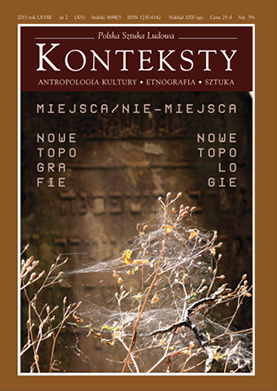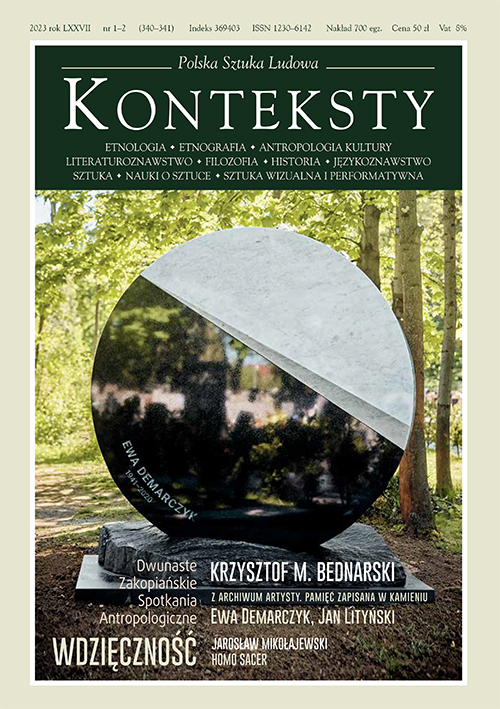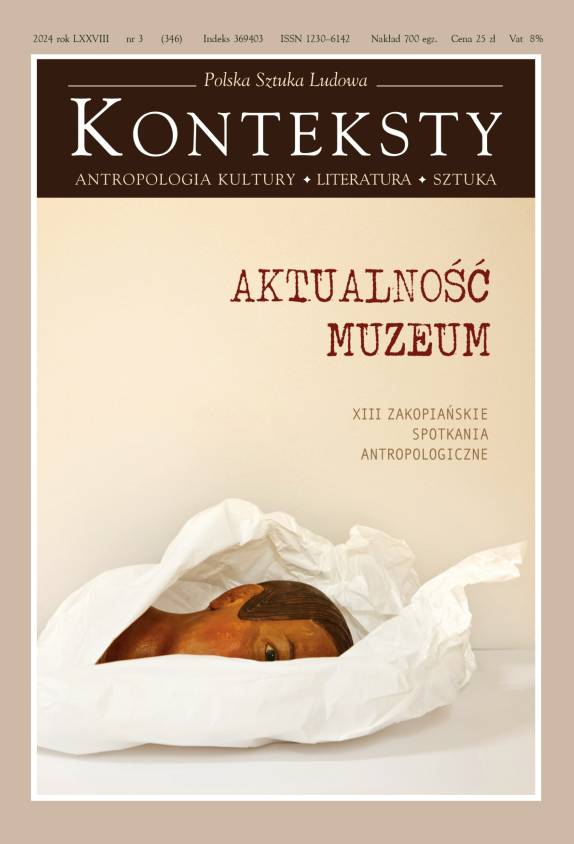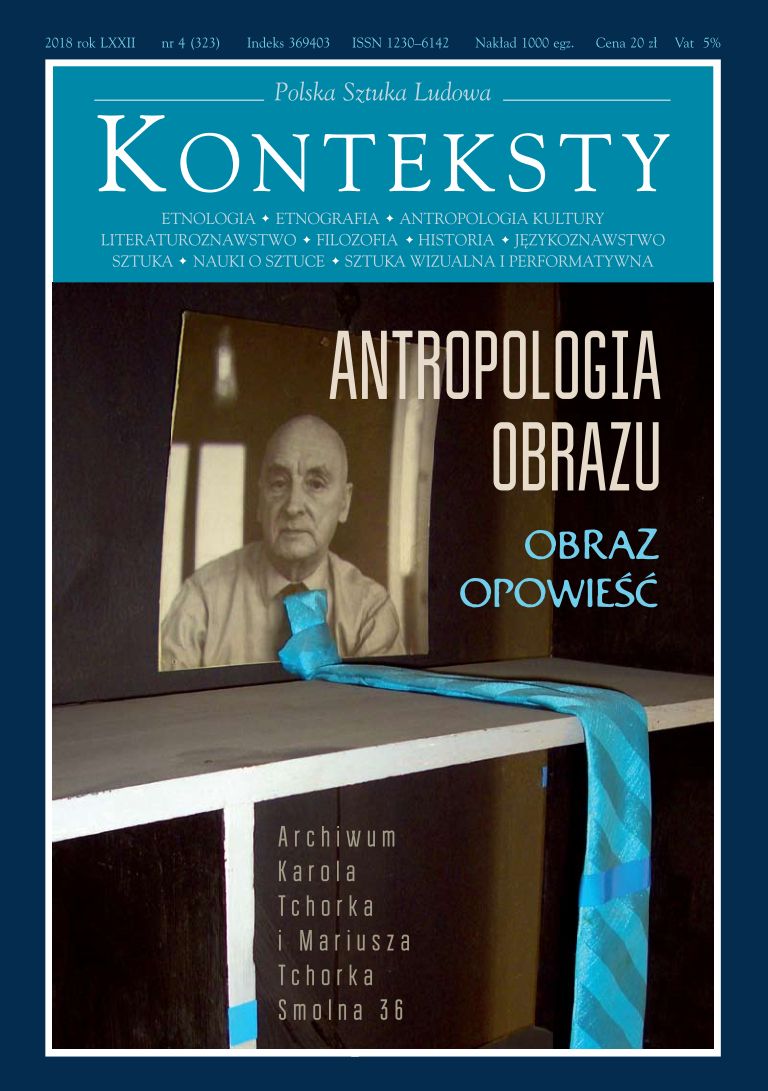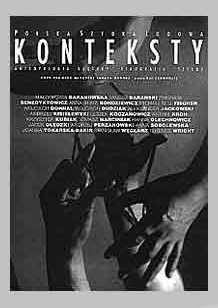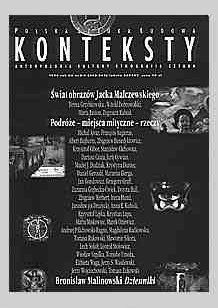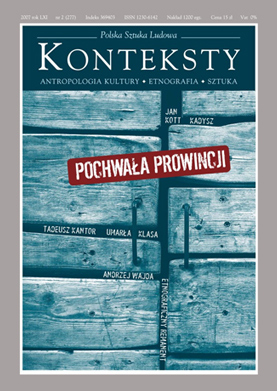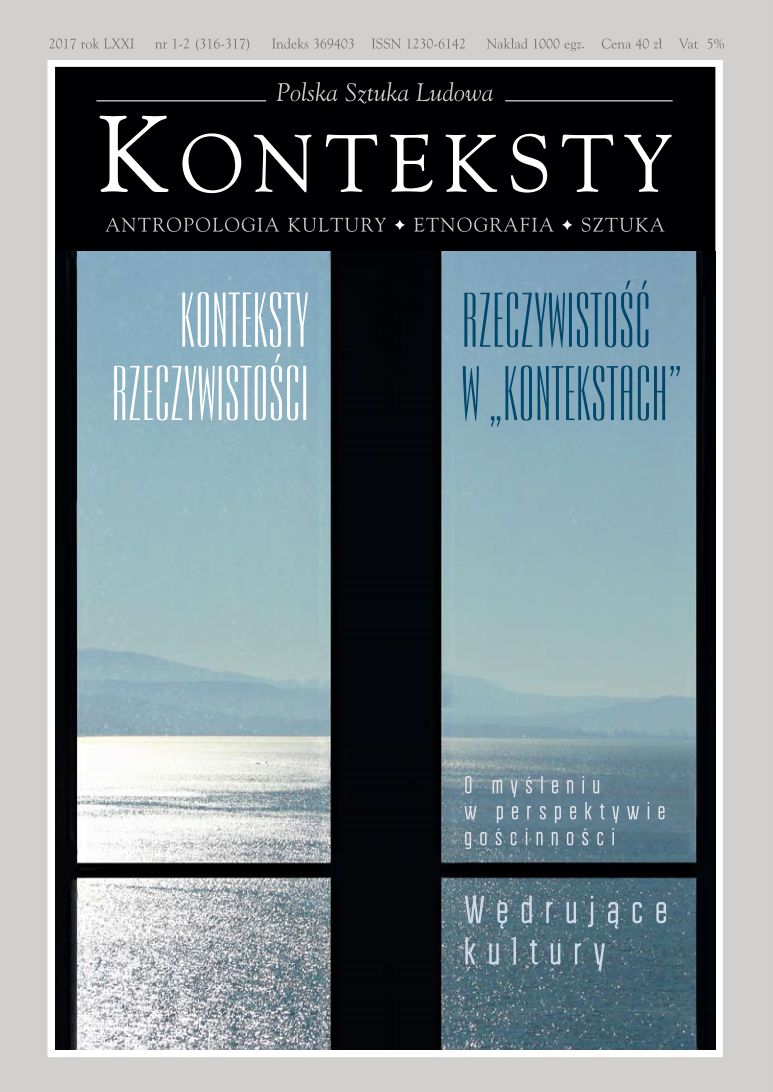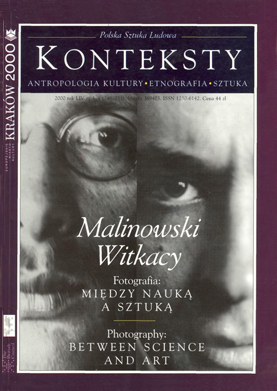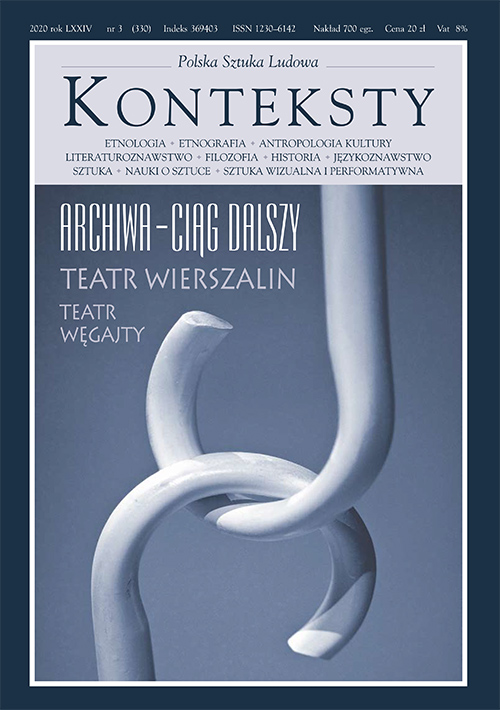Issue 2019/3 (326) - On Weakness / On Flying

| Prof. Lidia Kuchtówna’s Anniversary | ||
| Prof. Lech Sokół’s Anniversary | ||
| Danuta Kuźnicka | At the Institute of Art of the Polish Academy of Sciences without Anniversary Frenzy  | 4 |
Assorted performative undertakings were set into motion upon the occasion of the anniversaries of researchers dealing with the theatre, organised at the Institute of Art of the Polish Academy of Sciences: Prof. Dr hab. Lidia Kuchtówna (60th anniversary of scientific debut) and Prof. Dr hab. Lech Sokół (50th anniversary of employment in the afore-mentioned institution). Speeches and laudations were accompanied by solo and group renditions of songs, recitations, special stage design, and para-theatrical ventures. The organisers recalled the achievements of both celebrants. The interests of Prof. Lidia Kuchtówna – a historian of the theatre – were, and continue to be, focused on the Polish Modernist and contemporary stage and, predominantly, the accomplishments of director and theatre theoretician Wilam Horzyca, actresses Irena Solska and Barbara Krafftówna, as well as sets by Karol Frycz. In the course of the celebrations a laudation was presented by Dr hab. Danuta Kuźnicka and speeches were given by Prof. Dr hab. Jarosław Komorowski, Dr hab. Joanna Krakowska, and Dr Maria Napiontkowa. The celebrant was offered Światła na wszystkie strony. Prace ofiarowane Profesor Lidii Kuchtównie, a 400-pages volume issued by the Institute of Art of the Polish Academy of Sciences, edited by E. Partyga and J. Stacewicz–Podlipska and presented by Dr hab. Dorota Fox and Dr Barbara Osterloff. The anniversary of Prof. Lech Sokół, literary expert and historian of the theatre, comparatist and Scandinavian studies expert, still active researcher and lecturer, and in the past a diplomat, was an occasion for recalling that the Professor wrote about Witkacy, August Strindberg, and Henrik Ibsen. Speakers included Prof. Giovanna Tomassucci, Prof. Dr hab. Janusz Degler, Prof. Knut Brynhildsvoll, Janusz Majcherek, Dr Antoni Winch, Dr Przemysław Strożek, Dr Paweł Płoski, Prof. Dr hab. Tomasz Kubikowski, and Prof. Dr hab. Wojciech Dudzik. Prof. Dr hab. Marta Skwara and Dr hab. Danuta Kuźnicka recited their poems. The celebrant received a commemorative book: Gangliony pękają mi od niewyrażalnych myśli. Prace ofiarowane Profesorowi Lechowi Sokołowi, ed. by M. Hasiuk and A. Winch: a total of 489 pages containing 50 articles. | ||
| For Lech Sokół | ||
| Wiesław Juszczak | The Origin of “Die Frau ohne Schatten”  | 10 |
The correspondence between Hugo von Hofmannsthal and Richard Strauss, initiated in 1900 and conducted until 1929, is an extraordinary document of the work performed by the composer and his most acclaimed librettist. Among selected letters pertaining to the titular composition, created in ca. 1911-1917 initially on the margin of several others, including predominantly two versions of Ariadne auf Naxos and two ballets, Die Frau ohne Schatten still remains the peak achievement of this so-called hardworking friendship, which produced seven operas and a project of an eighth one (Die Liege der Danae), preserved in initial sketches on the libretto, interrupted by the poet’s death. | ||
| Maria Napiontkowa | Exercises in Strindberg  | 19 |
This text – written for an anniversary book dedicated to Professor Lech Sokół – is a presentation of three “approaches” made by Tadeusz Łomnicki to Strindberg’s protagonist in three different dramas: Pariah and The Father by Strindberg and Dürrenmatt’s Play Strindberg, i.e. an adaptation of The Dance of Death. The first two texts were shown by television theatre, and the third – in a traditional theatre. Łomnicki prepared each role with the assistance of such means of artistic expression, which best rendered the very essence of the dramatis persona. We receive three – seemingly – realistic portrayals of the so-called strong man, together with his unchanging opinions about the world, who dominates the reality surrounding him. Their realism remains illusory since the assumption of the actor’s message consists of demonstrating a certain type of behaviour characteristic for man regardless of the time and environment in which he lives. Łomnicki was interested more in the visualisation of the idea or the phenomenon than in portraying an individual. | ||
| Lech Sokół | Poems | 29 |
| Niska Street Seminars | ||
| Lidia Kośka | Lec, Purim Reading  | 31 |
An attempt at recounting the biography of Stanisław Jerzy Lec as well as characterising his works from the perspective of two dates: 6 March 1909 and 13 Adar 5669, which coincided with the day of the poet’s birth, albeit owing to differences between the Jewish and Gregorian calendars they usually diverge, thus creating a symbolic hiatus for experiencing his oeuvre and its determinants. The time of Lec’s birth is rendered exceptional by the fact that the event took place in the course of Erew Purim. The philosophical sub-texts and formal symptoms of this holiday (a carnival reaction to an unsuccessful extermination) could cast light on the poet’s works and show their satiricial aspect from a viewpoint different from the usual one. Within this perspective of formulas of putting on masks, changing costumes, and concealment, omnipresent in the case of Lec (demonstrated and analysed in this article), it is possible to perceive also the shadow of an image, which could have appeared before his eyes on that “day of first astonishment”. | ||
| On Weakness | ||
| Stanisław Krajewski | Weakness as Strength  | 46 |
By limiting available measures we render ourselves weaker, but if we attain our goal then we demonstrate strength – the sort that would otherwise remain concealed. This is the case in classical mountain climbing and mathematics. First examples are to found in the Bible: the Torah tells the story of Jacob and Esau: the strength of the latter gives way to the weakness of the former. Nonetheless, subsequently Jacob’s strength is demonstrated; obviously, his mission calls for self-restriction. True, an unconstrained battle waged in accordance with the ideal of non-violence is extremely difficult. Even Ghandi, its most renowned propagator, was well of aware of this fact. The limitation of this ideal in relation to the situation of the Jews was indicated by Martin Buber, otherwise a radical adherent of non-violence solutions worth applying whenever it is possible. A new epoch - that of messianism - must take place so that weakness could become the prime source of strength. | ||
| Paweł Próchniak | Weakness of Poetry. Glosses to the Diatribe “Przeciw poetom” by Witold Gombrowicz  | 52 |
The author focuses on a constellation of texts on Gombrowicz’s diatribe: Przeciw poetom, including well-known, appreciated, and oft-commented sketches and notes, such as a quasi-letter by Czesław Miłosz with its impertinent beginning: ”Mr Gombrowicz!”. Ignored texts include a polemic by Józef Łobodowski. Finally, there are poems, two of which (Komentarz by Stanisław Baliński and Wstęp do Traktatu poetyckiego by Miłosz) were subjected by the author of the sketch to contextual examination, thus showing the manner in which they embark upon a subtle polemic with the Gombrowicz diatribe and, at the same time, render the weakness of poetry its paradoxical, but also deeply human strength. | ||
| Dariusz Czaja | Sarcophagus and Door. On Fragility  | 58 |
Chernobyl Prayer by Svetlana Alexievich is a multi-text organism whose meaning can be projected in many ways. While reading the book the author of this article omitted several essential discourses among those most often exposed in analytical texts: political, technological, religious, futurological, etc., and concentrated predominantly on the existential discourse: a register of the suffering, pain, and death experienced by the participants of the catastrophe. The conclusion contrasts two metaphors present in the discussed text: ”sarcophagus” and ”door”, suggesting that they summarise two contradictory modes of thinking about the Chernobyl catastrophe. | ||
| Paweł Drabarczyk | The Weak Pursues Life  | 70 |
“I walked across the camp in Auschwitz. I brought back a stone from the railway track. Its presence made it impossible to endure being in the studio”. Thus Kōji Kamoji commented on the circumstances of the origin of Auschwitz Stone (1988). A humble stone - or rather a constellation of several stones - appears also in, i.a. the central part of Hiroshima (1995). In both cases, these are not the immense monoliths to which the aesthetics of monumental loftiness has accustomed us, the sort that usually serve extremely powerful events under whose weight history collapsed. Kamoji’s response to the “powerful” dimension of conventionalized aesthetics of borderline events appears to be weakness, including the one characterising the inconsequential and fleeting material he uses to build installations surrounding the stones: melting stearin changing into smoke and vapour and used for making candles suspended on small nooses with the wicks facing downwards (Auschwitz Stone), or the shadow of a slashed kimono on a wall, as if an afterimage of those who vanished in the nuclear flash (Hiroshima). Those “weak” traces are a sensitive medium in which the unimaginable, which evades the gaze, resonates. Kamoji is a Buddhist although, as is quite natural in Japan, we recognise also numerous Taoist elements in his art. Many works appear to be permeated by the thoughts of Lao Tzu: “A man is born gentle and weak; at his death he is hard and stiff. […] Stiffness is thus a companion of death; flexibility a companion of life”. | ||
| Agnieszka Bednarek-Bohdziewicz | Servant Subservient to the Master… Mickiewicz’s Prediction of Weak God Theology  | 77 |
The servant – God, the master – man. The curiously reversed metaphor of the God-man configuration is revealed not only in the cited fragment of the poem: Rozmowa wieczorna (Conversation at Evening); the need for reflection and the re-establishment of the man-God relation already after the secularisation power to “disenchant” the world comes to the fore in numerous fragments of Mickiewicz’s distinctively religious oeuvre The author of Zdania i uwagi (Sentences and Comments) perceived the revolutionary dimension of Christianity, its subversive nature dealing with a weak God surrendering to suffering and open towards man in need of His help in the world. This reflection is shared not only by Silesian mysticism (in particular the poetry of Angelus Silesius), but also by related post-secular reinterpretations of Christianity based on the theology of Paul of Tarsus and his conception of “power made perfect in weakness” (2 Corinthians 12, 9–11). The theology of a weak God formulated by John D. Caputo (and contained in his The Weakness of God. A Theology of the Event ) constitutes a context providing a new instrumentarium for deciphering and presenting the unique religious thought of Mickiewicz. | ||
| Janusz Bohdziewicz | Will of Weakness  | 84 |
The purpose of the sketch is to contemplate weakness outside the established scheme of its evaluation in an opposition to strength or might. The essay is inspired by a widely comprehended current of “weak thought” and comprises a commentary to the book by Julia Kristeva and Jean Vanier: Leur regard perce nos ombres. The prime message of the article is formulated in the course of meditation on human plight and images of happiness – weakness could be a solution beyond a juxtaposition of violence and helplessness in the face of life leaning towards moderation, originating from the acceptance of existence as a gift and not as property. Subsequently, within the context of the relation with the handicapped this reflection assumed the form of an outline of a project of social, civilizational, and metaphysical transformation. Naturally, this modest sketch merely proposes reflections and further work on the titular issue. | ||
| Jacek Leociak | Weakness and Strength in Religious Experience of the Time of the Holocaust On “Jom Kipur” – an Essay by Icchak Berenstein  | 91 |
An analysis of Jom Kipur, one of the essays written in the Warsaw ghetto by Icchak Berenstein (?–1942), discloses a specific type of religious experience within the domain of paradox, doubt, and rejection. Berenstein developed a personal theology of the Holocaust. The author of the article placed in the centre of his interpretation reflections on the concept of “helplessness”, crucial for the text. In Berenstein’s meditation helplessness brims with meanings that overlap each other and reveal their paradoxical nature. Here helplessness possesses a purely human, sociological, and historical dimension: everyone is helpless in the face of the horror of the ghetto. It also has a spiritual, religious dimension: it constitutes doubt, a process of turning away from God and forgetting the Ten Commandments. The dialogue between God and man expires. In the case of Berenstein we are dealing with the experience of theological inversion and are entitled to assume that this reversal allowed him to touch the untouchable mystery of the Holocaust. The forbidden (reaching for moral self-knowledge and the power of constituting independently what is good and what is bad) is now enjoined. Man becomes thrust into the hell of the knowledge of good and evil, enrooted only in him. This is the satanic temptation suggested to man by the serpent of the Book of Genesis. In Berenstein’s writings it is God who condemns man to enjoying knowledge reserved for Him. The phenomenon of essays by Icchak Berenstein consists of close relations between the present and eternity, material detail and universal sense, concrete event and exemplum, secular and holy history. The topography of the Warsaw ghetto, with which the author of the article is thoroughly acquainted, becomes part of eschatological topography. | ||
| Katarzyna Prot-Klinger | Two Sides of a Monument  | 100 |
The Monument to the Ghetto Heroes in Warsaw has two sides – Struggle and the Holocaust Procession. The monument in question links the topos of Procession and Funeral Procession, but it is “Struggle” that is selected as the site of social practices. The author of the article wonders whether both this and other monuments are helpful for working through trauma or negate loss by concealing their “other side”. The fundamental question asks: “Can commemoration fulfil a function concurrent with the term ‘memory site’, change the ‘non-represented’ into a symbol and thus lead towards integration of experience?”. Social and personal experience shows that memory sites can be of help in making contact with a traumatic event, but ultimately the process of social working through is a sum of individual processes of integrating traumatic experience. | ||
| Michał Klinger | Weakness and Death. Attempts from the Phenomenology of Creative Phenomena  | 106 |
Anthropological weakness is a dominant of the body. The article presents the cultural body-love-death topos upon the basis of numerous works, such as Une Charogne by Charles Baudelaire, the motif of “the raising of Lazarus” in Crime and Punishment, Russian Orthodox hymns, et al. The analysis produces an image of solidarity between God and man within the drama of corporeality and not within transcendence, evoking their “co-dependence” in sui generis pantheism possessing existential-personal features. “What will you do, God, when I die?” (Silesius, Rilke in Russia). “What is man?” against the kenosis of God. The mystery of evil does not exhaust the mystery of man. His vocation is creativity (Berdyaev), whose outcome is not foreseen even by God. Nonetheless, man succumbs to kenosis – “in the image” of God? | ||
| Leszek Koczanowicz | “No Country for Old Men…”. Two Phenomenologies of Aging: Cicero and Améry  | 111 |
The article discusses old age and the role played by that stage in life at the time of (post)modernity. In order to fully accentuate the specificity of (post)modernity the author of analysed three conceptions of old age. The first was depicted by Cicero and enables us to comprehend the idea of old age in Classical antiquity. The second, formulated by Jean Améry, allows us to interpret the manner in which old age is perceived in modern times. The third is an interpretation of old age in the Dutch bestseller: Little Happiness Experiments /The Secret Diary of Henrik Groen, 83 ¼ Years Old, which, in the opinion of Leszek Koczanowicz, provides insight into the way in which old age is understood in the postmodern era. | ||
| Krzysztof A. Meissner | Weak Impacts  | 117 |
Weak impacts, ostensibly absent and non-essential, prove to be of key importance for our origin (surplus of matter over anti-matter in the early Universe), existence (sunshine), and end (the exhaustion of fuel on the Sun) – ignoring weakness could become a cardinal error… | ||
| Marta Zimniak-Hałajko | Anthropology as an Instrument of Studying the Experience of Failure  | 119 |
Reflections presented in this text consider the social dimension of experiencing procreation failures in Poland – first and foremost, unplanned pregnancy, abortion, and unsuccessful treatment of infertility. For several years the author conducted studies applying the participatory method by becoming involved in various roles in institutions that co-organise the experience of procreation failures by defining them and rendering help in crisis situations (predominantly clinics specialising in treating infertility and pro-life organisations). Pertinent studies made it possible to devise anthropological tools for studying failures and an attempt at sketching the complexity of experiencing it, involved in extensive social contexts (ideological discourses, the activity of social sub-systems, concepts and practise, as well as genres and forms of expression subjected to conventionalisation). | ||
| Marcin Jarząbek | Weakness of Field Studies, or on the Strength of Powerless Informants and the Weakness of Researchers  | 128 |
Upon the basis of selected examples of widely comprehended field studies (from the domains of ethnology, history, oral history, and sociology) the article analyses tactics applied by informants who in relations with the researcher hold a weaker position as regards cultural capital, communication tools, and interpretation. In such situations weakness becomes a stand used for severing contact, a maximum limitation of contents relayed to the researcher, or the concealment of selected motifs and themes. By distinguishing and discussing assorted tactics: silence, desultoriness and evasion, deceit and lies, the process of drawing attention away and “cunning complaisance” the author of this article pointed to a situation in which research is used by the informant for the sake of rendering his opinion public and empowering it. Finally, he indicated that the manner of approaching the weakness of the Other unintentionally reveals also the weakness of the researcher. | ||
| Tomasz Szerszeń | Weak Archives of Destruction. Notes from a Journey to H., N. and F.  | 134 |
What sort of an archive will remain after the end? And what is the relation between archive and catastrophe? Today, in an era of an encroaching climate catastrophe, this question once again becomes topical. In order to understand what will possibly await us in the future we should study, probably while paying greater attention, other catastrophes – those, which had already taken place. This text attempts to chart concepts and images associated with the atomic apocalypse and such sites of human and non-human destruction as Hiroshima, Nagasaki, and Fukushima but also Auschwitz, Chernobyl and… Pompeii. | ||
| Tadeusz Bartoś | Culture as Source of Weakness According to Friedrich Nietzsche. How Culture Weakens Man’s Creative Potential  | 138 |
The reception of the thought of Friedrich Nietzsche is threatened with an unhampered interpretation, sometimes also contradictory in the case of assorted commentators. This tendency is the outcome of the openness of the conceits applied by the German philosopher as well as the aphoristic and non-systemic form of his statements. The concept of weakness, whose reverse is strength, will, and will to power, also calls for a careful approach because up to this day the most evocative and superficial interpretation is the Nazi one. Praise of power, force, vitality, and great spirits has, however, little in common with the mental and reactive aggression of the complex-ridden leaders of the Third Reich. In his writings Nietzsche proved that the cult of weakness and servility is the outcome of Christian culture. In this sense his philosophy is that of culture, and his essential research target consists of discovering the concept of strength, forgotten in Christian civilisation. Nietzschean reflections were actually not adopted in our culture since the rules of social behaviour are still governed by vital mechanisms of resentment. | ||
| Jan Szpilka | When Gender Is Weak  | 141 |
In Płeć słaba. Zagadnienie obecności the author of this article brought the reader closer to the problem faced on both cultural and language levels whenever we try to express our secular identity in categories transcending the binary woman/man division. By referring to Hannah Arendt’s reflections on the relation between power and private life and the possibility of participating in politics Jan Szpilka presented the way in which the question of “gender possession” impacts our possibility of being publicly present. | ||
| Magdalena Barbaruk | Amereida’s Nights Comments on the “Travesía de Amereida” Diary  | 146 |
The author proposed a “verbal” comprehension of weakness as a process in which cultural identity comes into being. In doing so, she indicated that in Euro-American tradition strength and weakness remain closely connected, with “strength” annexing “weakness” as its instrument of expression, or else depends on overcoming weakness, shown so clearly in the depiction of Ernesto Guevara’s travels across South America. The author also claims that weakness and resultant practises could become a foundation for the “ethics of weakness”, a separate “immanent frame” (Ch. Taylor). An analysis of the diary of a poetic expedition: Travesía de Amereida (1965, published in 1986), whose purpose was a new poetic foundation of America, serves the above-presented theoretical remarks. | ||
| Piotr Jakub Fereński | In Chains of Weakness  | 155 |
An article dedicated to the contemporary situation of science in Poland and other countries: the USA and Hungary. The author paid special attention to the humanities and social sciences, and is interested in the condition of the university primarily from the viewpoint of two fundamental heteronomies of institutionalised knowledge, into which he included financial and political determinants. In doing so he asked about the role of the humanities within the context of neo-liberal ideology, contemporary economic processes, technological progress, bureaucracy, power, education, democracy, and the media. | ||
| Monika Sznajderman | Empty Field  | 161 |
The presented fragment comes from the book: Pusty Las (publishing house: Czarne, April 2019). Puste pole is the story of the author’s life in Wołowiec, a village in the Beskidy Mts., from which successive inhabitans vanished: the poor, seeking better fortune acrosss the ocean, visionary oilmen, Jews, Gypsies, and members of the Łemko community. It is also an homage paid to this place on Eartth, its history, Nature, and population. The author deciphers the Beskid Niski Mts. and Wołowiec – her place on Earth, the site of existence on memory meadow and in gaps left beind by the former inhabitants of the land of the Łemko people. These gaps and ranges of a void – invisible at first glance – appear amidst words, called by their name. | ||
| Dorota Koczanowicz | The Creative Force of Privation  | 172 |
The article is about the situation of a creative crossing of limitations accompanying cooking. One can speak about the affiliation of shortage and creativity by using examples of daily kitchen tasks performed by mothers and grandmothers, although haute cuisine chefs too appreciated the force generated by privation. The text focuses also on borderline wartime events. In the case of famine and a struggle to keep alive the selflessness of creative cooking as well as the effort of documenting, in the form of recipes, fantasies about the past and cooking in the past proved to be a helpful instrument for surviving the most oppressive situation. The effectiveness of this strategy is confirmed vividly by the example of women from Ghetto Theresienstadt. | ||
| Łukasz Sochacki | Il Festino di Santa Rosalia a Palermo. Notes about Weak Ethnography  | 177 |
By using the example of the “Festino di Santa Rosalia” festivity in Palermo this essay presents ways of rendering religious scenarios (e.g. myth, rite) topical within a current political and social context. The last part of the text attempts to justify the necessity of including ethnography (conceived as a research method) into the framework of the interpretation theory proposed by G. Vattimo. | ||
| Krystian Darmach | Night-time Field Work Journal. Palermo and Weaknesses of an Anthropologist  | 188 |
The weakness of an anthropologist and anthropology, both trying to dig into night-time (non)reality. A predilection for night life, the weakness of description, the weakness of worn out anthropological categories and conceptual apparatus tackling night-time experiencing of a town; research situations generating cognitive problems faced by the subject. The night, which makes it possible to skulk and hide oneself. To speak freely and to do away with everything or put it in inverted commas. In spite of anthropological / scientific civility. Anthropology written in black ink, night-time temperament. In a state of exhaustion, cognitive weakness, and confrontation with the power of language, under the pressure of senses, impressions, and doubts. The author of the article proposed a camouflaged, reflective view of his attempt at field studies – in Palermo by night. | ||
| Maciej Krupa | Quietude, Stillness, Calmness  | 193 |
Walking is a weaker form of activity than driving or riding, regardless whether on horseback, a car, or in a tram or a train. If this is true then what is weaker than walking? Apparently, the answer is: only motionlessness. Its synonyms are immobility and a certain static quality, but also rest and numbness. Perhaps then the terms we seek are: non-walking, stopping. But non-walking and motionlessness posses a certain negative quality, while we are concerned with something positive. In English a single word: stillness would suffice. In Polish we are compelled to use at least three words: calmness, motionlessness, and silence in order to render the meaning of stillness. The adverb still means, i.a. “motionlessly”. The adjective still denotes “immobile”, ”quiescent”, “silent”, and “dead”. Here the home belongs to the sphere of immobility and stillness; the legal definition of a home, a building, and a lot is “real estate/immobility”. Mobility denotes homelessness associated with changing places, the absence of enrootment, motion. Homo viator is a traveller, a pilgrim, a wanderer, a man on his way. Walking is a weak form of travelling due to its far-reaching limitations – speed, exhaustion, and the need to rest. | ||
| Kuba Szpilka | Weakness  | 197 |
We are familiar with weakness, experience it personally, and encounter it all around us. It constitutes a scoop for media coverage, a fundamental and ever-returning space of art. Multiplicity of references, ostensibly obvious significance, poignant closeness – but it is still difficult to speak about weakness. Already upon the level of language we confront considerable confusion. | ||
| Julita Dembowska | Place for ”Training Imagination”. The Władysław Hasior Gallery. The Tatra Museum in Zakopane  | 205 |
The Władysław Hasior Gallery is a specific space vividly marked by the personality of an artist whose undertakings referred to highly diversified material and methods of creating a work of art. His praxis inspired the establishment of the Gallery programme, which, on the one hand, strongly accentuates the historical context and, on the other hand, makes it possible to introduce motifs of contemporary culture and art. | ||
| Krzysztof M. Bednarski | Polish Thanatos  | 207 |
The fundamental element of the sculpture: Polish Thanatos is a boat, or, more precisely, a half – the second half remained in the frozen over Bug River. When asked why I used only half a boat I usually replied that the other half is on the other side, since a boat symbolizes transition from life to death and played such a symbolic role in assorted cultures from times bygone. A boat fulfils the same function which Heidegger granted in his phenomenological discourse to the diverse functions of the bridge, which not only connects but is conceived as the unity of the manner of being a bridge, gathering “the unitary fourfold”. | ||
| On Flying | ||
| Paweł Karol Gąsiorczyk | Several Remarks on the Beginnings of Contemporary Navigation – from Sea Vessels to Airships  | 210 |
For centuries people have dreamed of leaving the Earth, of soaring and feeling free. It would have been impossible for those eternal dreams to come true had it not been for the constant progress of human thought expressed in the incessant progress of science and technology based on the solid foundations of science, praxis, and the strivings of numerous generations. From the onset of aviation it was necessary to delineate the course in order to determine the direction of motion. This is the reason why use was made of the achievements of sailors, the first navigators and explorers of the Earth. In this article the author presented several remarks on the development of modern navigation, stressing that its beginnings go back to antiquity, when sea and ocean navigation was inaugurated and scholars interested in astronomy started to construct first instruments for the observation of celestial bodies. Next, he discussed the history of such devices as the compass, so-called Jacob’s staff, the astrolabe, the sextant, the logbook or the chronometer. All made a significant contribution to a better establishment of the ship’s position and determination of its course. A special role in the progress of navigation was performed by nautical charts – so-called portolan charts – created already in the thirteenth century. Successive pages of the article focus on the further advancement of astronomy and cartography, additionally accentuating the fact that together with the emergence of aviation use was made of the centuries-old experiences of nautics. By way of example, possessed knowledge is creatively transformed by, i.a. constructing airway beacons used in long-distance flights, particularly essential for night fights. Subsequent changes were the outcome of the application of radio navigation, while the use of electromagnetic waves and the beginnings of radiolocation proved to be a true milestone. The latest stage involves the development of satellite navigation. In his brief article the author attempted to present several remarks on the beginnings of contemporary navigation. By basing himself on the example of their history he also endeavoured to demonstrate man’s unwavering striving towards taming the forces of Nature and their use for his own purposes. | ||
| Joanna Gorecka-Kalita | Bird Metamorphoses: Suibhne, Picus, and Tristan  | 219 |
This article embarks upon aviantropistic transformation in the Old French poem: Folie Tristan (twelfth century), analysed against the background of two texts belonging to different epochs or cultures: an anonymous saga from the so-called historical cycle of Irish mythology, telling the story of the warrior Suibhne, who due to his sin and the resultant curse cast by St. Ronan was condemned to a “bird’s” existence in tree tops, and the tale of the mythical Picus, recounted by Ovid and Virgil, in which the son of Saturn and king of Latium was changed by jealous Circe into a woodpecker. Although in Old French texts the miracle factor was conspicuously reduced and subjected to essential rationalisation (in the Christian approach dominating from the Patristic era the possibility of a transformation of man into an animal is decidedly rejected and relegated to the domain of diabolical illusions) the conducted analysis shows fascinating similarities - evidence of the survival of a mythical substrate below the stratum of courtly narration. In this way, the motif of transformation into a bird gains a different dimension: unlike the mediaeval lais, marked with elfin miraculousness, it is not a poetic ornament but a trace of ominous, taboo-based punishment forcing to pose questions about the nature and limitations of humanity. | ||
| Magdalena Gubała | Fleeting Images of “Wings of Desire”, a Film by Wim Wenders  | 227 |
This analysis and interpretation of Wim Wenders’ Wings of Desire (1987) embark upon reflections on the sensual and corporeal aspect of experiencing the world and participating in it from the vantage point of the stand represented by Maurice Merleau-Ponty; it also draws attention to the aspect of an active embodiment of experience by the realisation of life via art. An essential role is played in the article by Gabriel Marcel’s concept of the necessity of extracting a higher level of the visible as well as by R.M. Rilke and his Duino Elegies. The author presented a thesis claiming that the film calls for noticing the superiority of a sensual and corporeal experiencing of the world in contrast to intellectual speculation. She also embarked upon the problem of the memory of transmissions and images, their record, language and speech. Finally, M. Gubała posed a question about a convenient perspective for the observation of images and their behaviour in an era of an excess of the visible. | ||
| Dorota Koczanowicz | Ascent and Force of Attraction of Daily Life  | 232 |
A discussion of the works of two artists: Marina Abramovic (The Kitchen) and Elżbieta Jabłońska (Supermother), dealing with the clash of heroism and daily life within the space of a kitchen. Everyday existence mercilessly demands to be realised. The uncompromising character of its verdicts does not spare either female mystics or free spirits-artists. After all, even the most spiritual person must eat and drink. In order to resolve the conflict between matter and spirit both artists reached for different traditions transcending mundane existence: mysticism and popular culture. Abramovic enters the kitchen in the manner of St. Therese of Avila, and Jabłońska puts on the costume of Superman. Is it necessary to soar above the Earth in order to feel that cooking, cleaning, and washing up do not surpass the strength of an average woman? Are body and soul condemned to an endless battle? The oeuvre of both artists suggests different solutions. | ||
| Rafał Kołsut | “Look! Up in the Sky! It’s a Bird. It’s a Plane. It’s Superman!”, or the Topos of Flight in the Superhero Comic Book  | 240 |
The prime intention of this article is to present (upon the basis of selected examples) the application of the topos of flying in American comic books about superheroes during the first phase of the former’s development (the 1930s and 1940s). The motif of persons endowed with super-human abilities and capable of overcoming the force of gravity is discussed in a wider context of mass culture works, which exerted a genuine impact on the appearance of the picture book genre defining the modern pop culture model of man. Particular titles and protagonists are mentioned in chronological order, spannig from the folklore of nineteenth-century England and the penny dreadfuls of the Victorian epoch, classical science-fiction literature, the Japanese kamishibai street theatre, and American pulp magazines to the onset of the so-called Golden Age of Comic Books and the Second World War. | ||
| Krystian Darmach | Flying Anthropologist. Reflection Above the City  | 247 |
An attempt at a contrary use of the ”bird’s eye view” metaphor in reference to the town conceived as a geographical and, predominantly, anthropological category. The town is perceived as an ideological, social, and conceptual product, albeit secured in concrete matter and its configuration and town-planning project, whose components ultimately reveal only in meta-reflection their co-dependent relations, mutual embroilment, and purposes embedded in the symbolic stratum, social life or economic determinants. In flight ”I” am the centre. I gaze from afar. I am a point of view and the town is a point of reference. I am an application of the town. In an illusory cloud of objectivity, although gaining an awareness of the body, hierarchy, matter, co-dependence, and space of a dialogue with the city. By setting myself free from customary sensory interactions in order to notice and rethink them. To take note and reflect in the face of assorted levels of objectivity. Vis a vis various levels of involvement in the world, primarily secured in the psycho-physical meaning of the word but also the conceptual, added, and scientifically oriented one, whatever that may mean. Impressions, sensitivity, and reflection bound together as two sides of a medal /coin showing us their full appearance precisely in flight. | ||
| Wiktor Szymborski | Angels, demons or maybe a man? Remarks on the medieval attempts to fly in the air  | 251 |
The aim of the article is to show the medieval attempts to fly in the air. It describes both the authors of theoretical works (f.e. Roger Bacon) and the most known people who tried their luck in flying with the wings attached to their backs. The author mentions also the concept of airships floating in the sky. He tries to explain what the motives of such dangerous attempts could have been. To achieve that he evokes legends – about Daedalus and Icarus, Alexander the Great, king Bladud, Gerbert of Aurillac and Albert the Great. | ||
| Joanna Wojnicka | Stalin’s Falcons. Mythologisation of Aviation in Soviet Stalinist-era Cinema  | 264 |
A presentation of the Soviet, and especially Stalinist propaganda myth connected with aviation and pilots, and in particular its cinematic representation. The myth in question appeared in Soviet propaganda already in the 1920s although, understandably, it reached its apogee in the 1930s and in wartime motion pictures. Its foundation was composed both of communist scientific prometheism and the demands of imperial propaganda. In the art of the 1920s it belonged to the domain of propaganda undertakings which, just as all over Europe, accentuated futuristic fascination and the progress of modernity. During the 1930s Stalin regarded the titular myth as one of the pillars of Soviet gigantomachy. This is the reason why authentic successes enjoyed by aviators and technical projects became the theme of art, spanning from music (the famous Aviators March) and painting (Alexandr Deyneka) to the cinema. Films accentuating this particular theme include, i.a. Alone (1931) by Grigoriy Kozintsev and Leonid Trauberg, Aerograd (1935) by Alexander Dovzhenko, works about the exploits of aviators: Valeriy Chkalov (1941) and Courage (1939) by Mikhail Kalatozov, and the post-war Tale of a True Man by Alexander Stolper (1948), based on the acclaimed novel by Boris Polevoy. The aviator myth lasted in the Soviet cinema well into the political thaw period although propaganda began to replace it with a more typical and appealing counterpart. Conquest of space was supplanted by that of the cosmos and astronauts took the place of aviators. | ||
| Michalina Lubaszewska | Dream – flight – adventure. “Arizona Dream” by Emir Kusturica  | 271 |
An attempt at following images associated with the symbolic of the air and the topos of the dream - experienced both while asleep and awake - in Arizona Dream, a film by Emir Kusturica. This motion picture, suffused with quotations and an intertexual game, a film with a “ludic” formal stratum, is governed by a certain concealed leitmotiv. The latter - as the author of article endeavoured to prove - is a quest for spirituality, a dream about spiritual transformation. The manifestation of this search consists of three motifs: wings (a symbol connected par excellence with the spiritual sphere), attempts at soaring in air in a handmade flying machine, and, finally, a leitmotiv merging the entire work: the image of a flying fish. The latter becomes the reason why two symbolic orders: aerial and aquatic, overlap. The permeation of the two spheres captured in the Kusturica film becomes as if an embodiment of reflections pursued by Gaston Bachelard, who searched for traces of that interference in literary imagery and poetic imagination. | ||
| Jerzy Konior | Why Does an Airplane Fly?  | 276 |
A presentation of an historical outline of the idea of flying objects and, in a popular form, the physical principles of their motion. The author cited studies conducted by Archimedes and Leonardo da Vinci as well as the construction of the Wright brothers airplane. By basing himself on the Bernoulli equation he discussed the concept and physical meaning of so-called aerodynamic force, responsible for the levitation of flying objects. | ||
| Rafał Nahirny | Assessment of Damage. The Gaze of Drones and the Militarisation of Visual Imagination  | 279 |
In 2013 Tomas van Houtryve used a universally available civilian drone to conduct an extensive planned photographic reconnaissance of US territory. For several months the drone flew over American parks, squares, and schools, taking a look at the daily life of the inhabitants present-day America. Consequently, there emerged a series of extremely ambiguous photographs in whose case it is easy to make a mistake and acknowledge that they were taken in Yemen or along the Afghan-Pakistan borderland. While analysing the van Houtryve photographs from the Blue Sky Day series the author of the article deliberated on the impact exerted upon visual imagination by images infiltrating from the grey zone of the still conducted war against terrorism. | ||
| Agnieszka Kaczmarek | Angels of a Lay Epoch  | 287 |
One of many attempts at deciphering the miniseries Angels in America (2003), directed by Mike Nichols and based on a play by Tony Kushner. The author of the article concentrated on analysing the American myth contained in the cable-film, a myth that in the 1980s underwent a metamorphosis involving a degradation of the WASP stereotype, the American dream of a community, and religion conceived as the latter’s foundation. This utopian project was replaced by the necessity of seeking new identity by those why no longer fit the existing contours of American ethics, and, more widely, that of Western culture – homosexuals, victims of AIDS, and representatives of minorities who ceased living in the semi-darkness and hiding places of the past. The presented text proposes an analysis of the depicted crisis and a condition, whose emblem continues to be illness, with the titular angels as the remedy. | ||
| The Magic Mountain | ||
| Grażyna Ruszczyk | Development of Resort Medical Treatment in the Nineteenth Century and at the Beginning of the Twentieth Century  | 296 |
This article is part of a book being written on wooden aarchitecture in selected Polish resorts. The author discussed various factors, which affected the development of resorts in the nineteenth century and during the early twentieth century. Prime causes included progress made by the medical and natural studies, and consequently resort medical treatment. Just as important was the growing number of writings enabling the promotion of hydrotherapy and medical facilities to reach wide social cirlces as well as advertisements and exhibitions presenting resorts and their products. The growth of medical treatment resorts, however, would not have been so rapid had it not been been for the expansion of the communication network and predominantly the railway, which considerably facilitated and reduced the time of travelling. Yet another significant factor took place in the case of Polish resorts – the involvement of social activists-patriots in improving the level and modernisation of local resorts so that they could serve society and the country divided by the partitioning powers. | ||






